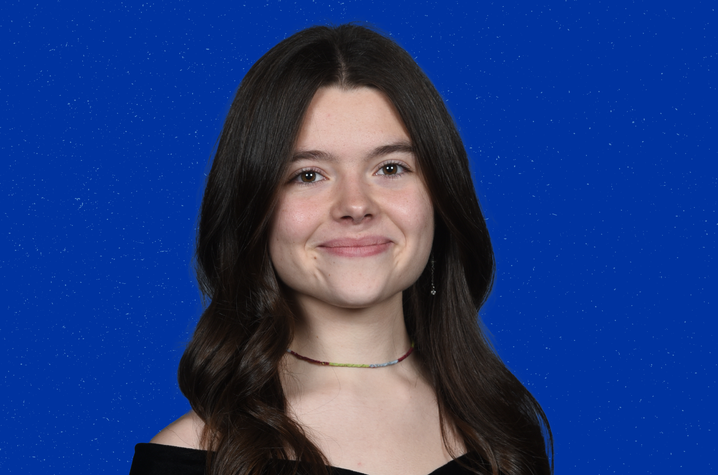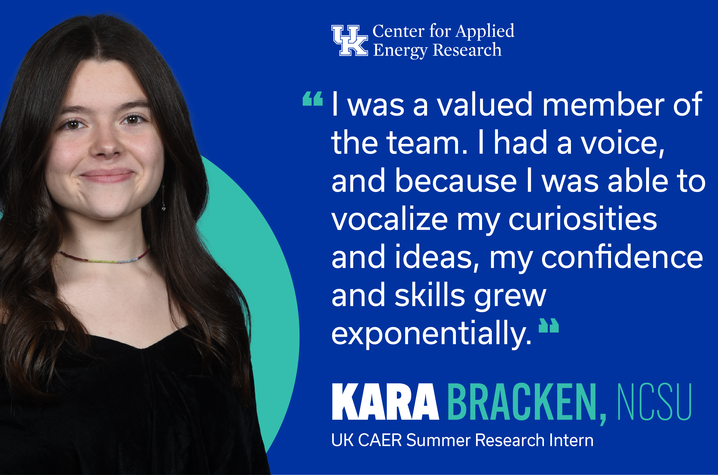Adapted from an original story published by the University of Kentucky News
Kara Bracken, a North Carolina State University chemical engineering major, spent the summer at the University of Kentucky’s CAER doing hands-on research.

There is no substitute for hands-on experience. The best way to learn is by doing, and experiential learning opportunities allow just that.
This is something that Lexington native Kara Bracken, a North Carolina State University chemical engineering major, found at the University of Kentucky Center for Applied Energy Research (CAER) over the summer of 2024.
Bracken has many ties to UK, including previous research in the Department of Horticulture in the UK Martin-Gatton College of Agriculture, Food and Environment as part of the Math Science Technology Center program at Paul Laurence Dunbar High School.
“I did really want to go home, you know going to school so far away can definitely be hard, so I was looking for opportunities at UK,” said Bracken.
Bracken asked one of her previous mentors about opportunities and was pointed to CAER. After an interview with CAER Associate Director Matthew Weisenberger, she was offered an internship. Bracken’s primary focus was to develop a multifilament spinning process for conductive PEDOT:PSS fibers.
PEDOT:PSS are flexible fibers with dozens of potential applications for electronic sensors, robotics, textiles and prosthetics. Bracken’s summer work sought to convert the PEDOT:PSS material from a liquid into wet, spinnable fibers, which can then be spooled and shipped to manufacturers.
Her experience in wet labs and fiber spinning will prove useful, regardless of what work she does in the future.
“I have a lot more familiarity now that I have those base skills that I can transfer to a lot of different things,” Bracken said. “As I moved through my lectures, labs and activities, I felt the impact of everything I learned. I can apply wet lab skills that I developed in fiber spinning to organic chemistry, analytical problem-solving techniques to chemical process principles, and ideas I learned studying capillary rheometry to physics.”
In addition to these transferrable skills in the lab, Bracken also valued the culture and mentor relationships that helped with her personal growth and development over the summer.
“Honestly, a lot of it is a strong research mindset, just having that initiative to dive deep into the concepts of what you’re working with,” she said.

That learning mindset is something that CAER tries to cultivate through its experiential learning programs.
One initiative of CAER’s strategic plan to is to strengthen the quality and distinctiveness of UK’s undergraduate and graduate programs through transformational experiences of self-discovery and learning, like Bracken’s summer experience.
As she reflects on her experiences with CAER and moves forward on her academic path, Bracken wants to be sure to express gratitude.
“Dave Eaton, Ashley Morris and Matthew Weisenberger — they all just did such a good job making me feel comfortable,” Bracken said. “That is honestly something that is rare, so I think it’s really important to acknowledge and appreciate that.”
It was a mutual feeling among her peers working in the lab.
“Her observation and problem-solving skills were a true asset to our team and helped us make progress on our project. She was always willing to do whatever needed to be done, whether that was a challenging experiment or cleaning up the lab,” said Leah Noble, a Ph.D. candidate in materials science and engineering. “I very much enjoyed working with and getting to know her this summer and hope that we have that opportunity again in the future.”
As a sophomore, there is still a long journey ahead for Bracken at NC State, with a potential study abroad trip and many opportunities in the research field to pursue. Just maybe, that road will lead her back home to Lexington once more.
“If the opportunity presents itself, I would absolutely love to go back.”
Bracken’s summer research was supported by a seed grant from the Materials Science Research Priority Area.